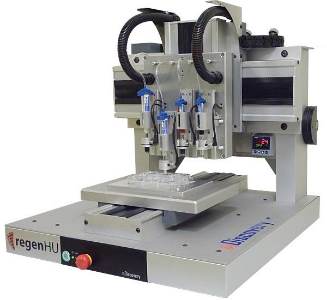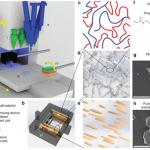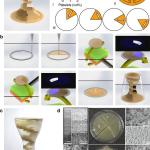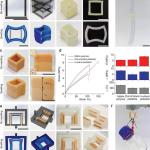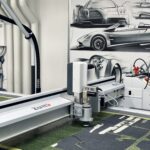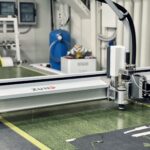The results of this process are multifunctional shape-changing soft devices that could be used to create mechanical means for joining parts in the human body such, as tendons and muscles, or for selective pick-and-place systems in soft robotics.
According to the researchers, the possibility of combining multiple materials in a single geometry within 3D printed objects allows for the creation of dynamic programmable objects—we’ve seen this in the past with inks loaded with cathode and anode materials for the direct wiring of lithium-ion microbatteries; or cases of combining cells with biocompatible hydrogels to explore the possibility of tissue regeneration. These 3D printed designs often resemble the approach used by living cells to grow biological materials in nature, however until now, man-devised structures have been unable to reach the same level of complexity: “independent local composition and texture control provide living cells with at least two additional degrees of freedom as compared with regular 3D printing process,” they explain.
Inspired by the elaborate heterogeneous architectures found in natural materials—such as plants who change their shape in response to environmental triggers—the researchers have devised “an additive manufacturing route that enables programming and fabrication of synthetic microstructures within a five-dimensional design space. Besides the 3D shaping capabilities of additive manufacturing, such a design space also includes local control of composition (+1D) and particle orientation (+1D).”
We’ve seen 4D printing in the past, for example, in the case of these complex self-fodlding structures created with 3D printed shape-memory polymers, however in order to achieve ‘5D programmability,’ the Swiss researchers used inks with magnetically responsive particles suspended in a light-sensitive liquid resin. They then used a modified commercial 3D printer, 3DDiscovery’s regenHU, to deposit the inks.
The customized 3D printer was equipped with four independently addressable syringes that can be charged with inks with different formulations. A two-component mixing and dispensing unit is also integrated to enable a gradual change in the inks composition. As for the inks, two separate inks with distinct rheological behaviour were used: a viscoelastic ‘shaping’ ink, used to generate an outer rim; and a low-viscosity ‘texturing ink,’ printed within the contours.
To demonstrate their ability to achieve orientation, composition, and shape control with their MM-3D printing platform, the researchers printed a 3D object with complex geometry and an intricate heterogeneous microstructure unparalleled outside of nature. Called the ‘Helix’, the object has both convex and concave curvatures on the outside, and “locally concentrated platelets in the form of a spiral staircase that spans from the bottom to the top and smoothly conforms to the concave and convex outer surfaces of the 3D object.” The entire object measures just 18mm high with a circular base of 16mm diameter and a circular top of 10mm, with 60 circular layers throughout. The extreme complexity and small scale of the 3D printed object represent a man-made object that is closer than ever to the rich, intricate and efficient geometry of biological materials and plant systems.
The researchers were able to create both soft mechanical fastening parts and 3D shape-changing key-lock connectors. “While numerous other functionalities can be envisaged, we provide examples where the shape change of heterogeneous composites is exploited to fabricate soft mechanical fasteners that work through unconventional principles. The proposed concept does not require any chemical bonding and relies solely on the mechanical interlocking between parts driven by a programmed shape change of the fastening system.”
They proposed that the fastening system could be an attractive mechanical means for joining parts in the human body, such as tendons and muscles, while the reconfigurable key-lock connectors could be used as autonomously trigged flexible joints, soft building blocks with reversible click-type links, as well as selective pick-and-place systems in soft robotics.
The study was led by Dimitri Kokkinis, Manuel Schaffner and André R. Studart and funded in part by the U.S Air Force Office of Scientific Research as well as the Swiss National Center of Competence in Research (NCCR) for Bio-inspired Materials, and ETH Zürich.
“The wide design space offered by the proposed MM-3D printing platform greatly expands the current set of toolboxes available for the design and fabrication of functional parts through additive manufacturing technology. Further exploration of such fabrication capabilities will also allow us to more closely replicate in synthetic systems some of the unique microstructural features exhibited by biological materials,” said the researchers.
“Using biological design principles as the guidelines within such a broad parameter space will likely accelerate the development of a new generation of smart composite materials with unparalleled properties and functionalities using more biocompatible, abundant and environmental-friendly resources.”
Photo 1’s caption: Schematics of the MM-3D printing platform for the creation of heterogeneous composites.
Photo 2’s caption: Actual MM-3D printed object with internal helicoidal staircase.The shaping ink is indicated in grey, whereas the texturing ink is shown in beige. Patterned black foils represent the lithographic.
Photo 3’s caption: Soft mechanical fasteners fabricated through programmable MM-3D printing of shape-changing objects.


